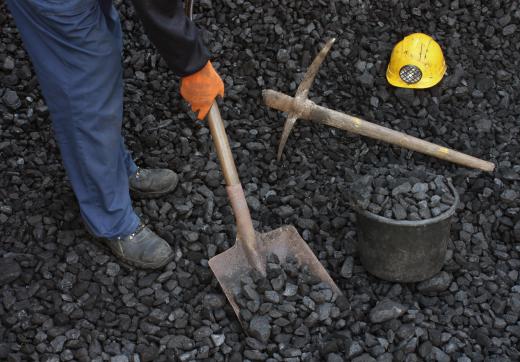What Is Anthracite?
Anthracite is the densest and purest form of coal and contains a high concentration of carbon and very few impurities. The relative purity of anthracite means that it burns cleanly and has a high energy density relative to other types of coal. This type of coal is difficult to ignite but, once lit, provides a powerful and steady flame over a long period of time. Physically, it is generally much harder than other forms of coal, does not generally crumble easily when touched, and tends to have a surface that appears slightly reflective or shiny, although its high carbon content ensures that it is still inky black in color.
All forms of coal are fossil fuels and are the result of geological forces acting on ancient deposits of plant and animal matter over the course of many hundreds of thousands of years. Most coal deposits are thought to have been laid down during the Carboniferous Period, roughly 300 million years ago. Pressure and temperature acted together to compress and transform this ancient plant matter, increasing its density and changing its structure.

The degree of temperature and pressure to which ancient biological material was exposed determined what sorts of fossil fuels were eventually produced. Anthracite is the product of more intense geological forces than other types of coal, although still not as much as some varieties of metamorphic minerals. Ancient biological material exposed to less extreme environmental forces, or with a different initial composition, was instead transformed into other forms of fossil fuels, such as soft bituminous coal.
Every sort of coal was used extensively during the industrial revolution, and anthracite was especially prized for its lower level of impurities and higher energy output, which made it ideal for many industrial applications. It was also widely used as a fuel for railroads, where its high energy density meant that less coal needed to be carried. Its clean-burning characteristics made it a good choice for use as a home and commercial heating fuel, a role that it served in the United States well into the modern era and which it continues to perform in much of the world.
Anthracite is mined using fairly standard coal-mining techniques. Surface deposits can be mined without the need for excavating large tunnel systems, whereas deeper deposits require more extensive excavation work and have historically proved to be risky places for miners to work. Recent anthracite mining has tended to focus on surface deposits for both cost and safety.
AS FEATURED ON:
AS FEATURED ON:











Discussion Comments
@cloudel - My grandfather also got black lung disease from being an anthracite miner. He didn’t know he had it until he turned sixty.
He had never smoked a day in his life, but he kept having trouble breathing. He started coughing up mucus. He struggled for air at times in a way that reminded him of the asthma he hadn’t experienced since childhood. He felt like he did when he had bronchitis, congested and full of phlegm.
The chest x-ray showed the marbling of black lung disease. He is on a transplant list now, and all we can do is wait and pray.
My neighbor used to mine anthracite for many years. He developed black lung disease, like so many others who worked in anthracite mines for years.
His lungs became coated with anthracite dust as he hacked out the coal and shifted it around. When struck, coal disintegrates easily into tiny particles. The lungs have bluish-black marbling that can be seen with a chest x-ray. Sometimes, it takes between ten and twenty years for someone to show symptoms.
Inflammation from coal particles causes fibrous scars to form. As the disease progresses, the scarred areas increase. This affects the function of the lungs, and the only cure is a transplant.
As a child, I was fascinated by geology. For Christmas one year, my parents got me a set of rocks and minerals. It came with various tools, such as slabs to scratch the minerals across to determine their hardness. It included a book of properties to help with identification.
I remember the piece of anthracite in the kit. It was very shiny and extremely black. I learned from the mineral kit guidebook that its high carbon content of more than 87% gave it its deep black color.
I also learned that different pieces of anthracite have different carbon contents. Based on these, they are divided into semi-anthracite, anthracite, and meta-anthracite.
Post your comments